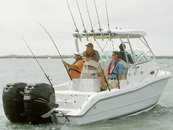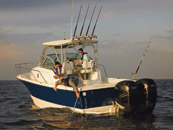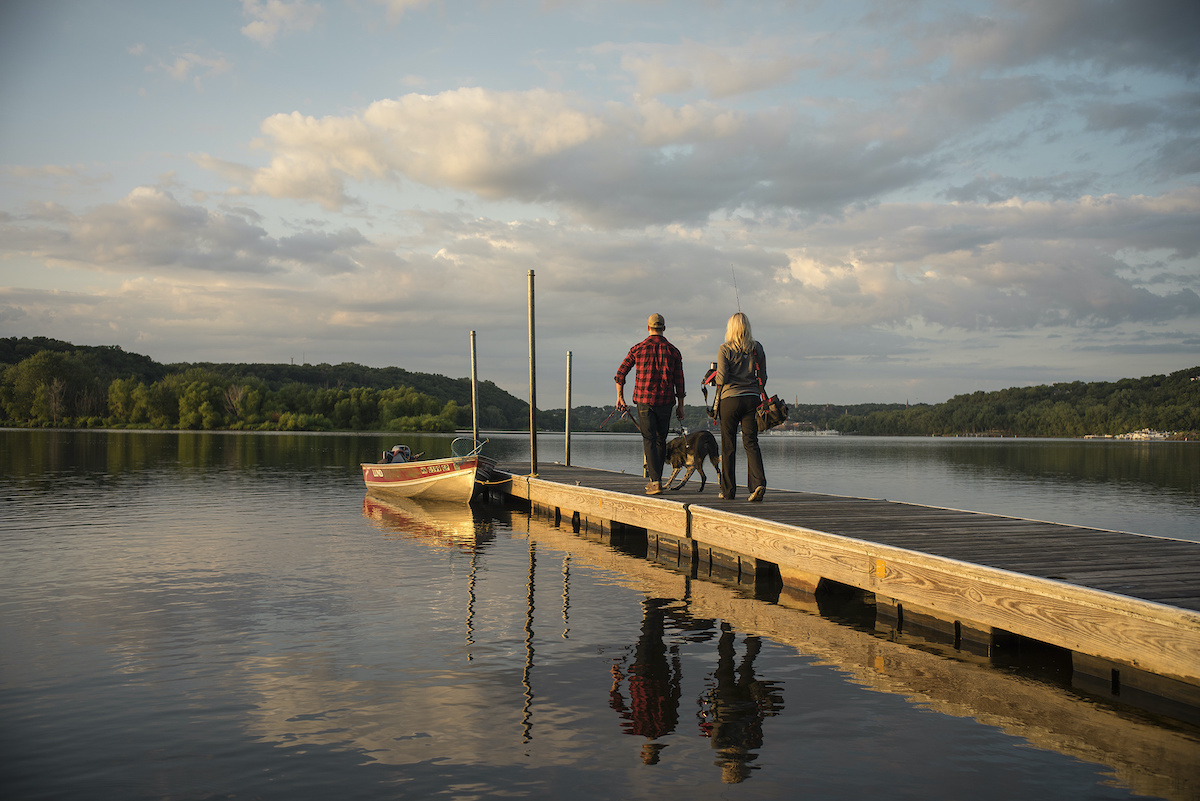Before catching fish, anglers must locate them. Much of North America is within a day's drive of the oceans, an estuary, or some other marine environment. You can find fish nearly anywhere there is food, oxygen, and cover. If you have a boat, your choice of fishing locations gets even larger.
Where Fish Live
Not all fish can live in the same kinds of waters. Different species need different sets of environmental conditions, including:
- Hiding areas, cover, structure, and the bottom
- Salinity
- Dissolved oxygen
- Water temperature
- Types and amounts of food
- Tides and currents
- Water depth
Structure
Many fish species such as striped bass and grouper live or hold near structure. Structure refers to changes in the shape of the bottom caused by rocks, reefs, manmade objects, humps, ledges, and drop-offs. Structure causes fish to concentrate in certain areas. Estuaries and river mouths may have shoreline structures such as docks, logs, stump fields, brush, rock piles, grass beds, and downed trees that provide shelter, shade, and protection for fish. Islands, sand bars, rock piles, and jetties are also good places to fish. Fish inhabit certain types of cover because it provides them with protection and puts them in the best possible position to catch a meal.
Salinity and Oxygen
Some fish species like brook trout cannot live with much salt in the water, other fish, such as tuna, need salt, and some, such as striped bass, can live in salt or freshwater. Fish also need a certain amount of oxygen in the water. Species such as carp can live on less oxygen than trout. Living plants add oxygen to the water as does moving water tumbling over rocks. Decomposing plants and animals use oxygen from the water and many kinds of pollution also reduce oxygen levels. Thermal pollution may also be a problem, as warmer water cannot hold as much oxygen as cold water.
Temperature
Each fish species has a specific range of water temperature that it enjoys. Tarpon can thrive in waters as warm as 85 degrees F, while salmon and cod must have cooler 50s, 40s, and even 30s. Some fish tolerate a wide range of temperatures; others have very narrow requirements. Serious anglers find that a thermometer is a useful accessory for knowing when to try for specific kinds of fish.
Food
The amount and type of food available in a body of water plays an important role in determining which types of fish you can hope to catch. The tides, currents, and water depth are also significant factors. Scrappy bluefish will retrieve lures right onto the beach while speckled trout haunt greater depths. Striped bass may slam baits on the surface, while perch will feed just above the bottom.
The Benefits of Using a Boat
Fishing from a boat enables you to cover more water than fishing from shore. You can reach distant spots, frequently with deeper water, and use a range of techniques and tactics not available to the landlubbers. Different types of boats work best in different types of water and for performing different tasks. Canoes, skiffs, and jonboats can be ideal for casual fishing on quiet estuaries, back bays, and tidal creeks. Larger rivers, open water, and more extreme fishing demand more powerful V-hulls, "cathedral" hulls, or specialty sport fishing boats.
Choose the Methods that Suit You Best
- Knowing which angling approach to use, and when to use it, is critical to having a successful day on the water. Locate a good tackle shop and ask a lot of questions. Buy a good chart of the area and study it for cuts and channels, holes or humps, all the good places that might hold fish. Maybe even hire a guide. A day spent fishing with a guide is one of the best ways to improve your technique.
- Once you find the fish, getting them to bite your hook becomes the challenge. Each of the various types of fishing lends itself to catching certain kinds of fish. Surf fishing usually lands a good variety of species, without the need for an ocean-going boat. Most any healthy beach can offer good surf fishing, but pay particular attention to rocky beaches, rock jetties, and fishing piers. A typical surf fishing setup matches an 8 or 9 foot rod and reel with 14 to 20 pound test line, although longer rods make longer casts. For many anglers, however, pier fishing can be the best possible way to spend the best possible day. Some piers stand over or near reefs or underwater structures that shelter numerous residents and draw schools of migratory fish. Pier fishing is a relatively comfortable way to introduce children to marine angling as the piers attract many smaller fish for the kids as well as larger species for the adults. Many piers also have the amenities and facilities families enjoy.
Inshore fishing means fishing within sight of land, often in estuaries, creeks, rivers, harbors, channels, and intracoastal waterways. It also generally means fishing from a boat near shore, whether that boat is a dory in a Newfoundland fjord or a flats boat working the Florida mangroves. Likely catches include tarpon, redfish, snook, trout, cobia, shark, striped bass, sheepshead, whiting, pompano, mackerel, permit, snapper, and grouper.
Offshore fishing is frequently out of sight of land, often miles out into the open sea. This type of marine angling demands a vessel that can handle the waves and heavy-duty tackle to handle the big offshore species. Most anglers fish offshore on a charter boat with a professional captain and crew, going for billfish, sharks, tuna, dolphin, amberjack, mackerel, and many other species according to location and season.
Trolling and Chumming: Effective and Enjoyable
- Either inshore or offshore, trailing lures or baits behind a slowly running boat enables anglers to cover a lot of water. Trolling is particularly effective for fish species that regularly feed on smaller fish. Outriggers--long extension spreaders--carry multiple lines out beyond the sides of the boat and enable trolling several lines at once. When a bait is struck, its line snaps free of the outrigger, to be played with a shorter, sturdy boat rod.
- Chumming involves ladling out dollops of ground fish, chopped clams, offal, or other natural attractors into the water to draw feeding fish. In some instances, the chumming forms a trail through the water that fish will follow for some distance. Chumming can involve a special-purpose, easy-to-clean grinder set up over one rail, or simply a bucket of chopped bait and a big spoon.
The Challenge of Fly Fishing
Fly fishing uses artificial flies designed to look like small bait fish. Initially focused on catching trout and salmon, fly anglers have taken on a full range of game and pan fish species. Many fly anglers use small boats even kayaks and canoes to get to hard-to-reach locations, even some inshore. Flies rarely weigh more than a dozen grams, consequently fly rods and lines must be specifically designed to assist casting the flies. Saltwater fly fishing is rapidly gaining in popularity, particularly in estuaries, river mouths, back bays, and near shore.
The Best Times to Fish
There is no single best time to fish. Like so much in this sport, different species are active at different times, and those active periods vary in response to a host of environmental factors. In general, marine fish seem to be more active shortly after dawn and at dusk, and least active around Noon and early afternoon. Nevertheless, you can still catch fish at Noon if you understand what the fish are doing and adjust your angling tactics.
Picking the Best Season
Just like trying to determine the best time of day to fish, determining the best season requires that you understand what the fish are doing and adjust your tactics to respond. Fishing can be a year-round sport, but obviously, certain seasons will be more comfortable than others.
Successful anglers know the habits and availability of the different species. A range of environmental variables determines which fish will be in an area at any given time. Temperature, amount of daylight, predation, and food availability are key factors. Striped bass storm the mid Atlantic flats in the warming spring; salmon invade the creeks of Alaska's Kenai in the long days of summer and early fall; and false albacore storm the early winter surf off Cape Hatteras.
Some species and some venues may also have times of the year when it is illegal to fish. Many states have closed seasons when various species are spawning. Successful anglers understand how all the factors affect their chances of catching a particular species.



